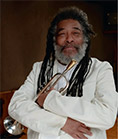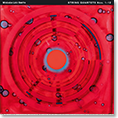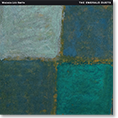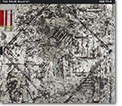THE MUSIC
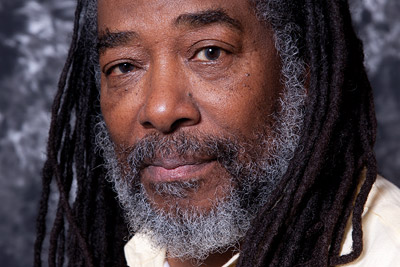
THE GREAT LAKES SUITES
The Great Lakes began to form at the end of the last glacial period around 10,000 years ago as retreating ice sheets carved basins into the land and they filled with melted water.
The placement of the lakes at the top of the Northern hemisphere of the Earth serves as a huge cape or umbrella and symbolically represents a source of food and energy and a means of protection for the entire globe.
My inspiration for composing the music on The Great Lakes Suites is centered around the idea of the Great Lakes being located in the uppermost part of the Northern hemisphere and the fact that it took a long time for them to develop and form as a large body of water. My score reflects the idea of the flatness of the lakes´ surfaces. The lakes´ flatness does not, however, imply for me stasis or inactivity. What I wish to express compositionally is the simultaneous notions of the lakes being flat and their volatility as the fundamental characteristics of the Great Lakes. Restrained, yet explosive.
The other quality I wanted to express in the compositions was multiple sectional forms, ideally, thinking of each composition as being a suite or set of multiple pieces.
In The Great Lakes Suites, I was not concerned with the types and differences of species that make their home in this great body of water, but more with The Journey - transportation, transformation, communication and the principles of wave formations.
Traditionally, the Great Lakes have only five in their collection. I decided to add Lake St. Clair to their number and, therefore, my compositions features six Great Lakes.
My compositions for the five Great Lakes are dedicated to Petri Haussila, who comes from the land of a thousand lakes, whereas "Lake St. Clair," or "Lake St. Clair Lake Oliver Lake," is for Oliver Lake.
New Haven, Connecticut, May 1, 2014
Wadada Leo Smith
...
WADADA LEO SMITH
"There´s nothing like the Great Lakes," mused Wadada Leo Smith in August 2012, while on a plane from Austria to America following a performance with Muhal Richard Abrams´ Experimental Band. "Why don´t I compose a piece for the most fascinating, the most powerful, the most life-sustaining, the largest body of fresh water in the world?" As he was composing, Henry Threadgill reminded him that Oliver Lake is also a Great Lake.
Between the province of Ontario in Canada and six states of the United States lie four of the Great Lakes: Lake Superior, Lake Huron, Lake Erie and Lake Ontario; the fifth Great Lake, Lake Michigan, is a long finger into the Midwestern United States. This chain of huge lakes has 21 percent of the world´s fresh water. In Smith´s grand suite, there is also the comparatively small Lake St. Clair, located in the passage between Lake Erie and Lake Huron, which has petitioned to become a sixth Great Lake; this, Smith suggests, can also be Lake Oliver Lake.
Three musicians in this quartet were born and spent their youths in cities near the Great Lakes, Henry Threadgill and JackDeJohnette in Chicago and John Lindberg in the greater Detroit area, whereas Wadada Leo Smith himself lived in Chicago near the beaches and harbors of Lake Michigan for several personally crucial years in the late 1960s. The Great Lakes they knew still bustle with shipping, fishing, sporting. There´s pollution, too - two of North America´s five largest cities are on the shores, as are six other major league cities, smaller cities and various industries. On the wide shorelines where cities and industry are not, vacation sites, forests, rugged lands and scenic areas are found. Long before the Great Lakes Quartet and us, the lakes were scenes of war - among Native American, Colonial, British and French forces; and between Iroquois and Algonquin-speaking peoples. For centuries before Europeans arrived, the Great Lakes were home as well as the route of commerce and communications between eastern and western peoples. And for a hundred millenia before life appeared, a vast glacier carved the lakes into the ground.
Yet, The Great Lakes Suites represent by no means program music or impressionism; there´s no portrayal of calm or stormy waters, of sailboats or islands, of ice or shipwrecks. The analogue is not Claude Debussy´s La Mer but rather much closer to the pure, direct beauty of his 1915 flute-viola-harp Sonata. In Wadada Leo Smith´s work, too, only the music matters; there are no external associations. True, the artist meditates on this world´s Great Lakes. What we hear, then, are beauty and purity from another world, Smith´s world. It´s a world with its own forms and bold sound colors and without the surface tensions of so much of today´s improvised music.
Above all else, Smith is a lyric artist. Everything else in his musical world - his composing, his improvising, his concepts of structure and form - flow from this fact. All of his composing and improvising "are one big connection." In a description reminiscent of the painter Picasso´s methods, he says: "I never set out to find out before I play, I discover that after I play, and when I´m composing, I never set out to know what I´m going to compose until I start taking notes and putting them into construction." His concentration on lyricism is self-aware. He traces his trumpet ancestry back even beyond Louis Armstrong, to the sensitive melodist Joe Smith, "the first really great lyrical jazz cornet player."
In Wadada Leo Smith´s trumpeting, there´s a fundamental sense of rubato behind his great freedom of motion. Silence as well as sound comprise Smith´s melodic lines. His spaces enhance the effect of his sounds and his phrases. The phrases contrast with each other, his lines move in distinctly shaped phrases. The sound of his trumpet moves, too. Basically, it´s a rich sound, full in all registers, which he varies with mutes and sometime vivid inflections. Hear his "Lake Ontario" solo, which starts with a marvelous, rough split tone, a note with undertones that make a little fanfare. While this solo has even more contrasts than a bop solo - sound, space, phrase shapes and directions, longer vs. shorter note values and phrase lengths, variable momentums from slow to moderately fast - Smith´s musical line flows gracefully, naturally. His enormous freedom leads to his sense of form: "I think that being a lyrical trumpet player means you can make extended melody that has the possibility of being a really large arc." His large arcs are ever so subtly and firmly made.
There are arcs of line in Smith´s composing. Always, he seeks balances of elements. Altogether, he composed 40 pages of music for The Great Lakes Suites; each CD can be listened to as a separate, satisfying three-movement suite. Most movements have several themes. He also composed parameters for his fellow improvisers-interpreters. Settings, textures change. For example, his opening movement of the second CD, "Lake Huron," includes eight distinct sections featuring different textures, mostly flowing one to another. An opening trumpet solo is in longer tones and a slow momentum over fast, busy bass and drums. After two themes by horns and rhythm, an alto sax solo is accompanied by variations on a medium-tempo bass-drums vamp, a tempo that continues under a second trumpet solo - hear how the three players spontaneously end this solo on the same notes. Threadgill also plays bass flute in this piece, and notice how many different sounds DeJohnette invents on his drum kit and develops into accompanying lines here and throughout The Great Lakes Suites. Smith´s quartet gives him so many subtle elements to balance in his textures and lines.
In his small 1973 book, notes (8 pieces), Smith wrote: "...each improviser creates as an element of the whole, only responding to that which he is creating within himself." "I still feel that way," Smith says. "When you do that, every voice in the ensemble can be heard for its own value. If you have three people or four or 25 people in an ensemble, every one of them should have a distinct way of being present, of manifesting what they´re doing in that composition and why they´re there. That´s what made special the orchestras of Duke Ellington and others from the past, where every personality in the ensemble means something and you can hear them."
What musicians! Smith speaks of "the kinesthetic energy that´s the spiritual dimension of the men who´re playing together, how they connect." In a very different way, Henry Threadgill´s playing in The Great Lakes Suites conveys senses of balance and of sound-space close to Smith´s rhythmic originality. Like most of his work in recent years, his alto saxophone solos here (on "Lake Michigan," "Lake Superior," "Lake Huron" and "Lake St. Clair") convey space, daring and nervous tension, with spiky notes and splintered phrases that develop into flowing lines. Then, on flute ("Lake Ontario") and bass flute ("Lake Erie"), he presents different styles: longer tones that also include cliffhanger intervals, spaces are filled. His sound is highly inflected, his vibrato is wide and slow. While there´s a center of calm in Smith, even in his occasional fast passages, there´s a sense of danger in Threadgill, even in his long-tone vibrato: Look out, he´s gonna get ya.
Against the free movements of the two horns, there is the busier activity of the bassist and drummer. Lindberg is closely attuned to the trumpeter. Sometimes, the bass line is as independent as the horn´s; at other times, as in the duet segments during "Lake Huron" and "Lake Erie," the bowed bass balances and sometimes imitates Smith´s phrases, they converse - his interplay is marvelous. He can also offer virtuoso lines that recall Charles Mingus, as in his fluttery opening to "Lake Ontario" and in his solos. Lindberg´s choices, for example, of notes, rhythm, momentum, to bow or to pluck, are invariably just right. Of course, such highly refined empathy is necessary in this music.
"Jack DeJohnette and I have never, ever struggled to play music together. I´ve always felt inspired when he´s playing the drums. The main reason is, I don´t have to figure out how to use my sound or worry what the count is or the nature of the activity he´s using - is it swing, is it this or is it that? What he does is he picks up the essence of each person´s creative energy putting that into the mix, as opposed to having a form that fits everyone in the ensemble, and the whole piece or the whole segment." DeJohnette´s feeling for textures is especially important in The Great Lakes Suites. Seldom do his textures become dense. He almost never impose patterns on the music, until the minute of funk that concludes the final piece, "Lake St. Clair."
So subtlety, sensitivity, virtuosity, balance, freedom of motion comprise The Great Lakes Suites by Wadada Leo Smith´s Great Lakes Quartet. Right now is a wonderfully fertile period in his career, as if Smith is feeling a second wind in the new millennium. What a joy that he´s so active and his work is now so well documented with productions such as this.
Chicago,
May 9, 2014
John Litweiler
...
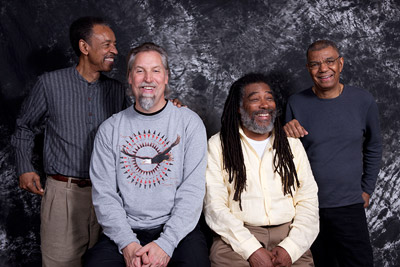
The Great Lakes
Quartet
(Wadada Leo Smith)
Their sonic waves reinforced by the deepest inspired
moments,
The Great Lakes
Quartet landed across town
Under high suspicion.
With voices they unfolded a majestic melody
So deep, sweet expectation,
Something new and
Old.
Exploration in all directions,
Sound locked by rhythm
In a research unknown.
Mystery.
That´s what the quartet revealed.
The garden in the center of the valley enclosed by
mountainous rifts,
From every direction,
A sea of inquirers emerged, toward the garden filed.
Calm, peaceful, silent, meditative,
They opened.
...
Wadada Leo Smith
(Wadada Leo Smith)
His silver horn´s sounds
Pierced the dense space,
Bold horizontal phrases choreographed
In distilled blood on fire.
It crossed into the dark night´s dusty way
Finding its flow
Slowly.
Just like the falling blue silk rain that cooled down the
hearts of Lovers
Just as the river found its course.
Sunbeams sonic-laced the listener´s field,
And each note enumerated, touched with
An effect fired up by creative energy force
Needed.
A sonata genesis.
Light can blind the source.
Let me stop here.
...
Henry Threadgill
(Wadada Leo Smith)
So effortlessly he plucks sonic crystals from the distance
Sky,
A star-stretched canopy just above creation.
His tonal spectrum,
A rich, lush canvas of melodic units culturally saturated,
Sonic sensation made clear in his choice and moods.
Magenta light rays fix his sound all blued up
Out of his Orange finger tips.
And everyone knew him as the author of the saxophone
sonnets,
In his music trance the young people saw the way.
I heard it too
Standing under a dark open sky.
Dangerous musical phrases vault straight out from his heart.
Can you feel that?
...
John Lindberg
(Wadada Leo Smith)
His hand plucked corrugated steel,
a resonant boom set forth a transformational
swish, doome, ssssscczz, and uuu—
A surgically precise signal targeted our hearts,
And he sounded out the music through perfect strokes.
His rhythms at times cross multiple sonic lines,
A blue and blush-orange hug was where the notes landed.
In that enclosed organic garden,
John´s musical vision - unfiltered - covered us
On the other side of the world.
Now.
I said that.
Yet, the mystery remains
Entangled in the soul of folks.
...
Jack DeJohnette
(Wadada Leo Smith)
His musical strokes are braille instructions of
explorations,
A clear, unimaginable majestic rhythmic field
Not chattered since the times of the great King Menes.
The drumming patterns are proportional rhythm unit-sets
Distilled in a two-thousand year history, not countable in
metric
Can only be measured in sonic equations.
Listen to the cymbal´s oval edge dome
Pulsating a golden beat crystal - crystallized metallic
plasma
Moves the fire phrase through illusionary forms.
Jack´s bass drum kicks
Set off silver-white velocity rings that are simultaneously
Healing elements for a future world, and a lover´s quest for
unity.
How powerful is that?
Again,
Can you measure the immeasurable?
Not the counters.
Feel every creative moment,
His drumming
Capture the telepathic energy of the performers
And in flows a magnetic music wave
Transcended.

